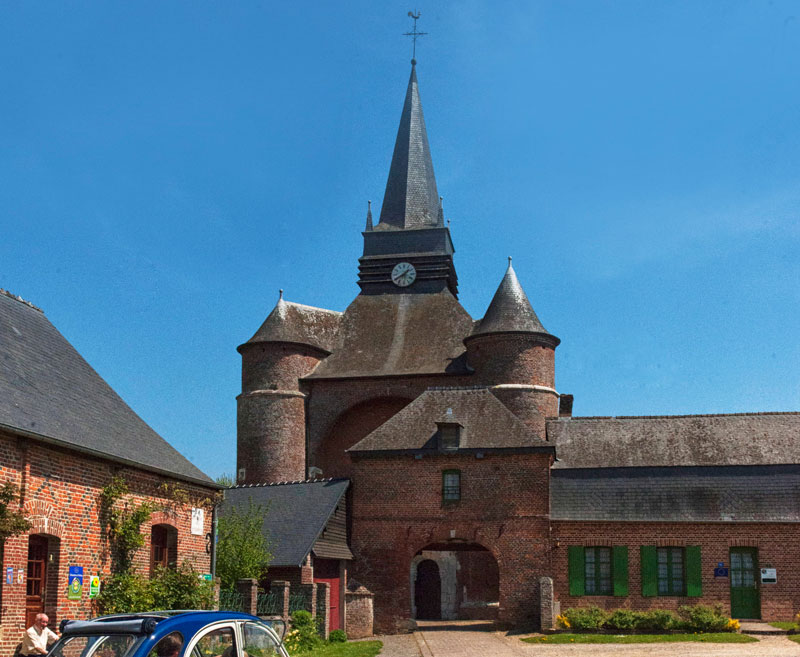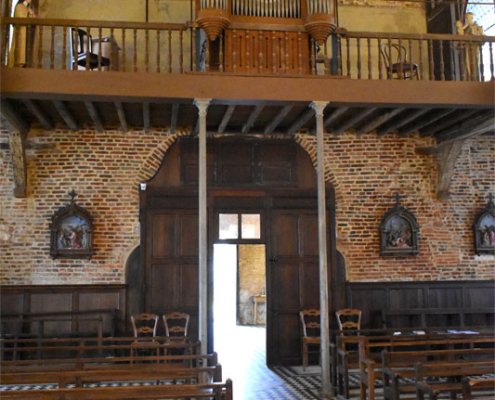by Ferne Arfin 10 July 2023
Discovering Aisne
The Fortified Churches of Thiérache

Photo courtesy of L’Aisne Tourisme
Imagine living in a neighbourhood where a fierce gang war rages. Even if you mind your own business, stay indoors most of the time, pay your protection money and don’t upset the gang members, every morning you wake up to more mayhem and destruction – windows broken, bins set on fire, animals slaughtered, wives and daughters attacked.
Now, imagine that this gang war started before your great great great grandparents were born and there’s no end in sight. In fact, it has been raging for almost 500 years. That’s the situation faced by villagers of the Thiérache region of Southern Picardy – now part of the Department of Aisne.
A field of endless wars
From at least the mid-14th century until well into the 18th century, soldiers and battles overran this narrow corridor of Northeastern France, stretching from the coast of Pas de Calais to the rich agricultural fields of Champagne and Burgundy. First, the French and the English fought each other on and off throughout the 100 Years War in the 14th and 15th centuries. Then the French kings Francis I and Henri II battled Charles V for the French throne in the 16th century.
Just when everyone thought it was safe to come out of doors again, the wars of religion consumed the rest of the 16th century until the Edict of Nantes decreed toleration for Protestants. Then the French and the Spanish – who had a hold on parts of the Low Countries – fought from the mid-17th century all the way to the 18th century under Louis XIV.
And every time the various nobles (when you think about it, the gangsters and protection racketeers of the Middle Ages) duked it out over the territory, the helpless villagers, who just wanted to get on with their lives without participating in all the carnage, witnessed various armies trample their crops, fire their barns, loot their meagre supplies and valuables, carry off their women and generally ruin their livelihoods until the next wave arrived.
The fortified churches
In some parts of the world, walled castles would have been the refuge of the locals when the nobles ran amuck. In Picardy, it was often only the churches that were big enough to shelter whole villages with their possessions and sometimes even their livestock. And from the mid-14th century, many of them were so fortified that they looked more like small castles and forts.
Thick-walled towers were added, defensive walls built to surround the church precincts, wells dug within church walls and sometimes within the churches themselves. The towers featured arrow slits and sometimes bartizans. No, I haven’t misspelled barbican (the word that describes defensive gateways and sometimes perimeter walls surrounding a fortress or castle). Some of the fortified churches had those as well. A bartizan is a turret or small tower that overhangs a wall and from which marksmen can launch arrows or pour stones and hot oil on attackers below.
Today, at least 60 of these unusual buildings are dotted across the Thiérache region of Aisne, east and northeast of Saint-Quentin. They look like small, steepled fortresses and, in essence, that’s what they were.
The Church of Saint-Médard in Parfondeval is one. Though not a soaring cathedral, it is a massive presence in this tiny rural village. It looks like a medieval military building with strong, squat brick towers, its entrance protected by a barbican gate. Even its slate-clad bell tower and steeple are built to protect those inside. Instead of the usual open arches, exposing the church bells, the bell tower is almost solid, the only openings being horizontal louvres through which the church bells – or alarm bells if the occasion required it – can be broadcast over the village.
Discover more about Parfondeval
Inside the fortified church
Parfondeval’s fortified church is one of the most accessible in the region. It is the only one that has been arranged to fully explain the history and use of the fortified churches. Inside information panels describe the defensive features of these buildings throughout the Thiérache region in French, English and Flemish. An unusually large vestibule for a church, suggests a space for the armed men of the village to muster to defend the entrance to the tower where the people sheltered. Space here and in the church sanctuary itself would have been used to store goods and perhaps shelter livestock. Villagers reached the refuge chamber by a spiral staircase inside one of the towers. Today, a soundscape and projected images tell the story. The large room beneath the bell tower was equipped for a long stay with room for supplies and even latrines.











Leave a Comment
What do you think?Please add your comments and suggestions here.